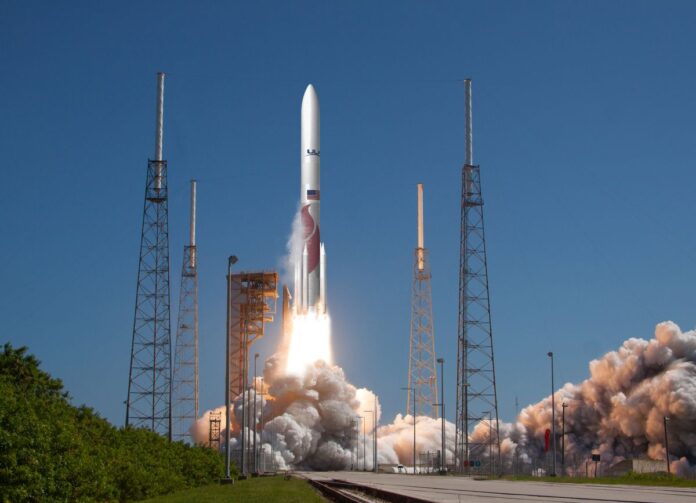United Launch Alliance’s (ULA) new rocket could fly for the first time less than two months from now.
In a call with reporters on Feb. 23, ULA CEO Tory Bruno announced that the company is targeting no earlier than May 4 for the debut launch of Vulcan Centaur, its powerful new rocket. The vehicle arrived at Florida’s Cape Canaveral Space Force Station via ULA’s RocketShip barge in late January and was then stacked to undergo tests and payload integration ahead of the upcoming launch.
At 202 feet (62 meters) tall, Vulcan Centaur is slated to replace ULA’s venerable Atlas V and Delta IV launch vehicles, which have served as the company’s workhorse boosters for over 20 years. Now, Vulcan is poised to take over the jobs of both. Equipped with two Blue Origin-built BE-4 methane/liquid oxygen engines in its first stage and up to six solid rocket boosters, Vulcan will be capable of lifting 7.7 tons to geostationary orbit. Atlas V and Delta IV’s mass to GEO capabilities max out at 4.25 and 7.25 tons, respectively.
Related: United Launch Alliance’s 1st Vulcan Centaur rocket arrives in Florida for debut flight
For its first launch, Vulcan will be carrying a payload trio to variable orbits, with one headed to the moon. Peregrine, a lunar lander from aerospace and robotics company Astrobotic Technology, will be the launch’s primary payload, and is one of several factors playing a role in Vulcan’s chosen launch date. Only a handful of days each month are available to launch Peregrine into its needed trajectory to get to the moon. During the Feb. 23 call, Bruno revealed that the Peregrine lander had recently completed testing at NASA’s Marshall Space Flight Center in Alabama and will be shipped to Cape Canaveral after a few final preparations are complete.
Vulcan’s other payloads include a memorial capsule from space burial company Celestis and a pair of demonstration satellites for Amazon’s Project Kuiper, which hopes to eventually compete with SpaceX’s Starlink satellite-internet constellation.
Celestis is a Texas-based memorial spaceflight company offering to send cremated remnants of deceased individuals to orbit and beyond. Celestis is using Vulcan’s debut to launch the DNA remains of four American presidents — Washington, Eisenhower, Kennedy and Reagan — as well as a number of past cast and crew of “Star Trek,” including Nichelle Nichols, DeForest Kelly and James Doohan, along with creator Gene Roddenberry and his wife Mabel Barrett Roddenberry.
The May launch date was partially chosen to accommodate the April target for another significant ULA mission — the Crew Flight Test (CFT) for Boeing’s Starliner capsule, which will launch on an Atlas V. Targeting May over April for Vulcan’s launch allows Starliner’s CFT mission to fit into the busy manifest of visiting spacecraft to the International Space Station over the next few months and gives Vulcan time for final vehicle checkouts and testing.
On Thursday (March 9), Vulcan rolled out to its launch pad at Florida’s Cape Canaveral Space Force Station for tanking tests and other trials. Payload integration will take place following those tests. Bruno also added during the Feb. 23 call that ULA and Blue Origin are still finalizing official qualification of the BE-4 engine.
Having slipped several times in 2022, ULA had hoped to launch Vulcan in the first quarter of this year. However, the ULA CEO voiced confidence in the company’s ability to carry out this mission and Vulcan’s next one, which will loft Sierra Space’s Dream Chaser cargo spacecraft. Both have to launch successfully in order for Vulcan to be certified for its first national security launch, planned for sometime in the fourth quarter of 2023.
Follow us on Twitter @Spacedotcom (opens in new tab) or Facebook (opens in new tab).

